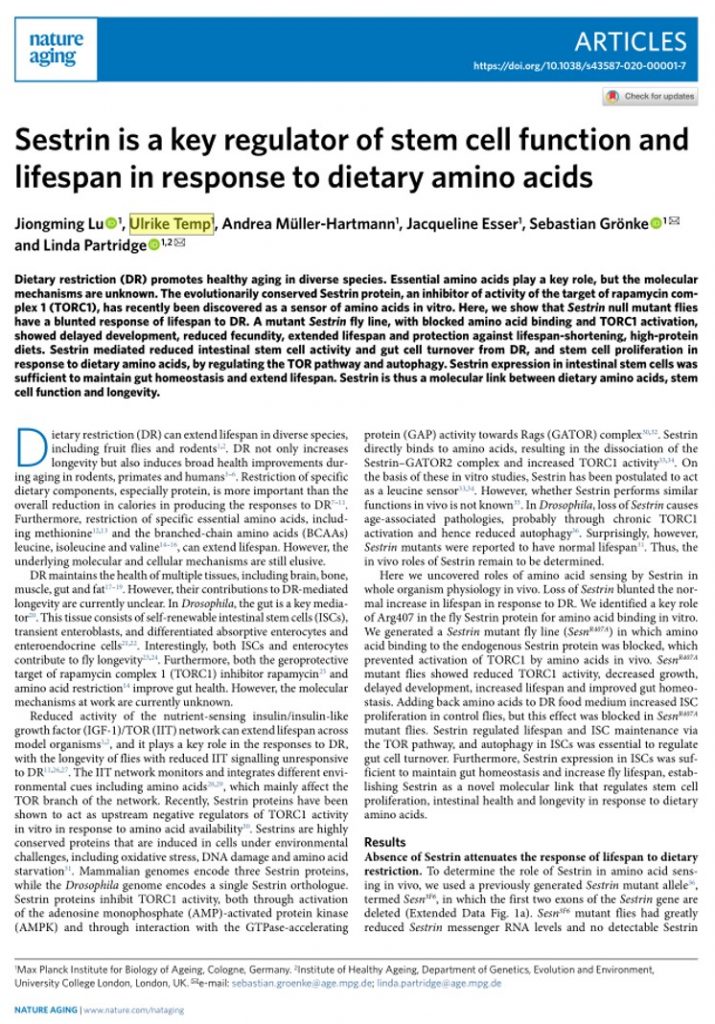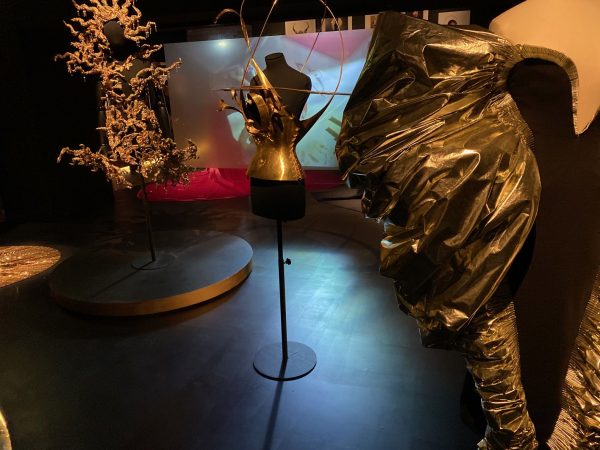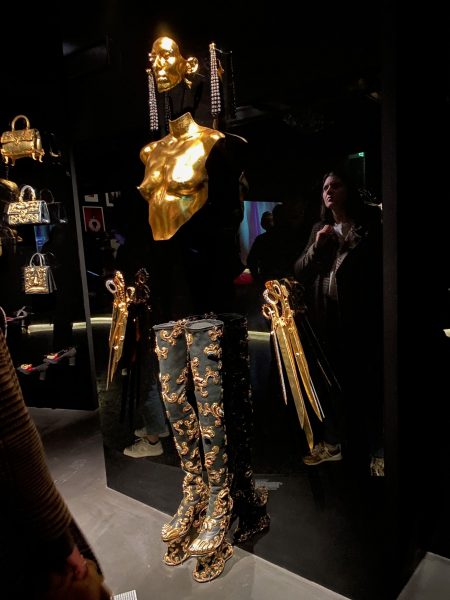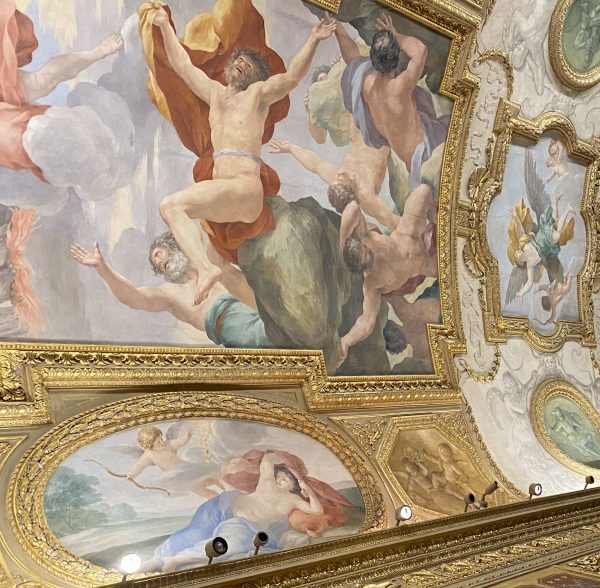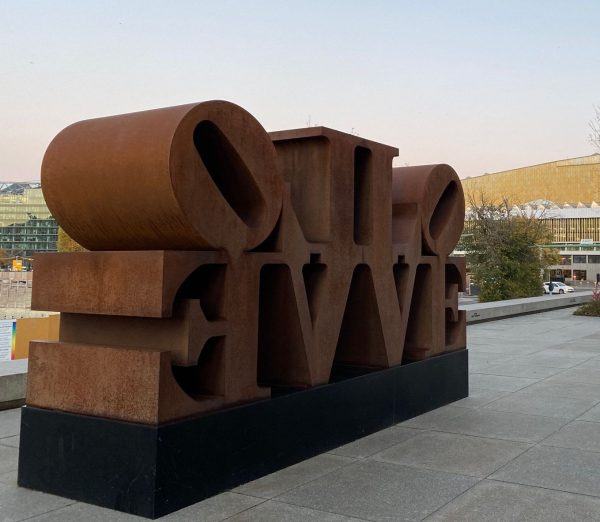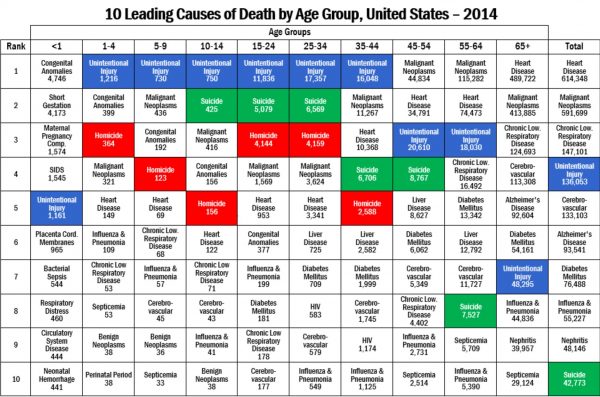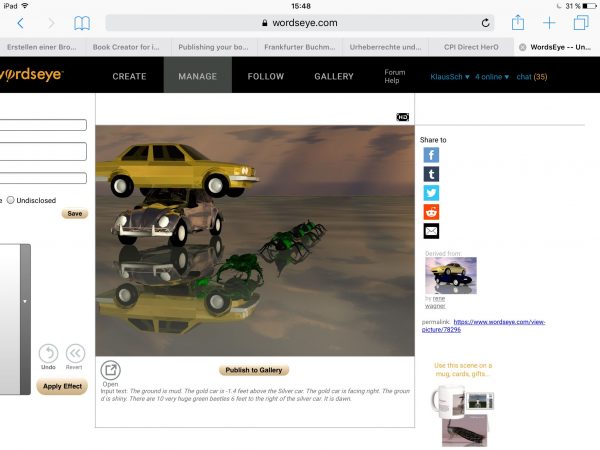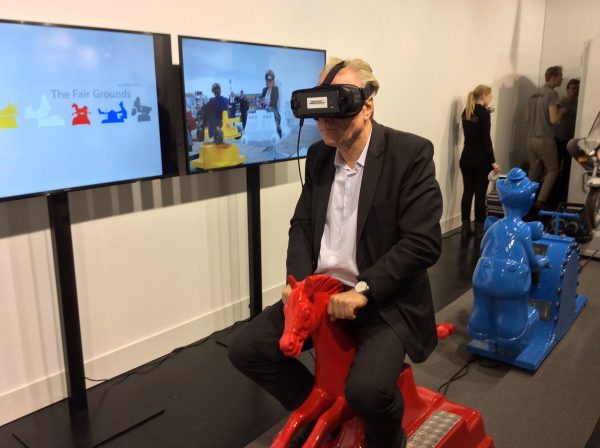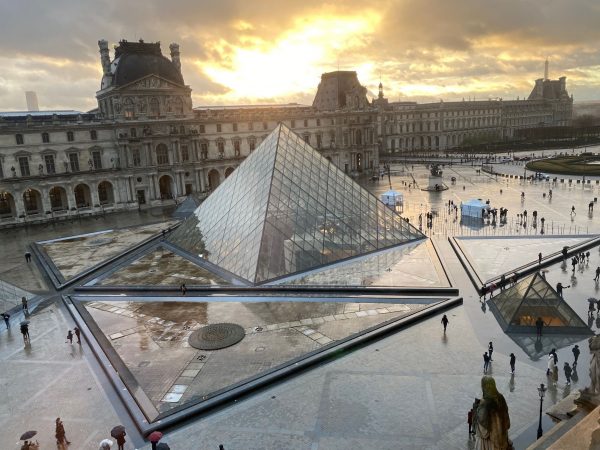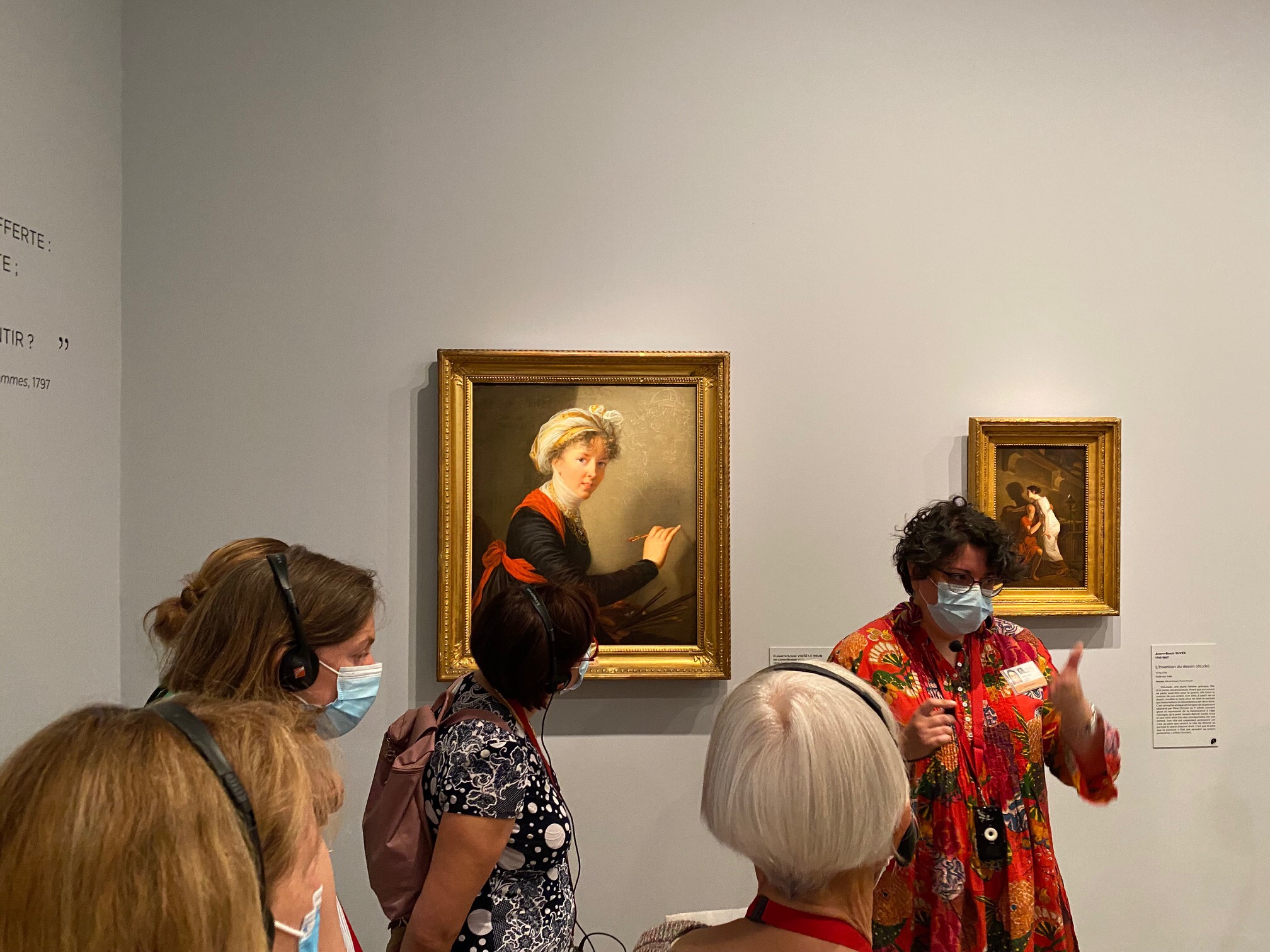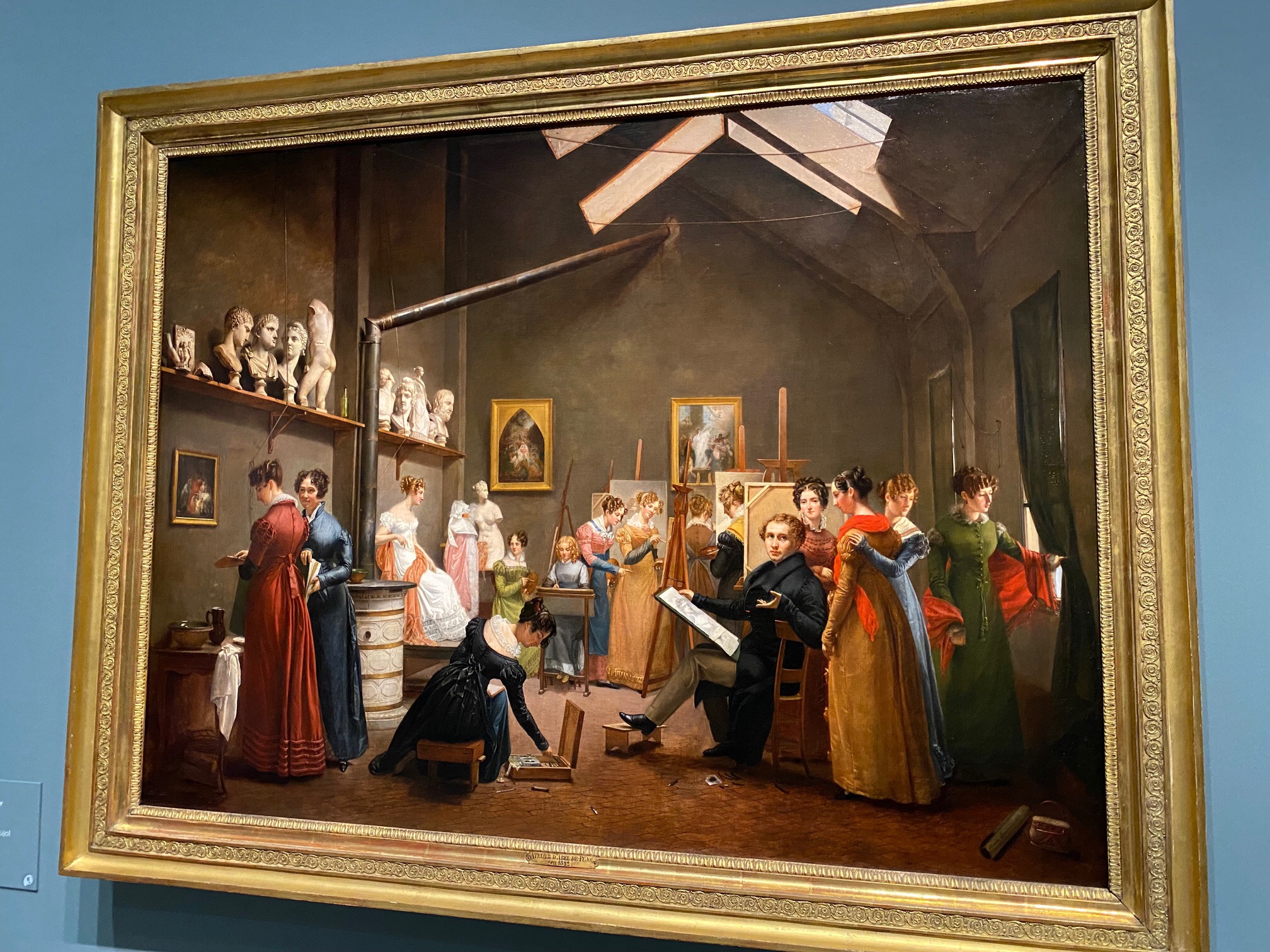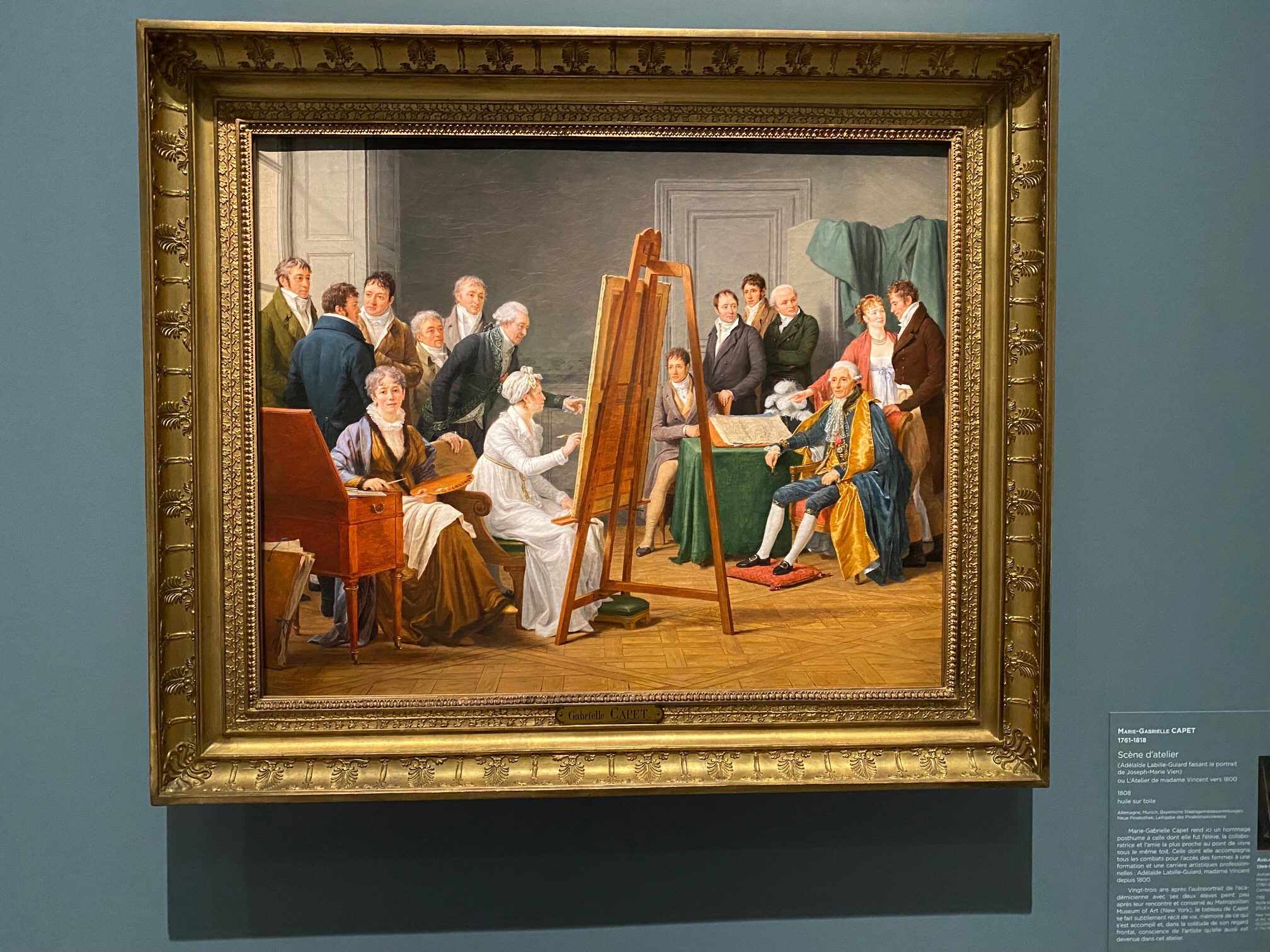Artists and scientists, all have their sources of inspiration. The most beautiful way of putting this is contained in a poem by Jacques Prévert. “Moi aussi, comme les peintres, j’ai mes modèles…”. The source of inspiration varies from physically present models to imagined ones. Painters and sculptors, we imagine, have their models right in front of them and build on their specific kind of observation, view and vision, seeing more or differently from others, at least since modern times. Poets and authors are believed to draw inspiration from abstraction and imaginative description and narration. Musicians tend to rely on hearing fine-tuned or creative tensions, as much as the resolution in harmonies through sequences of sound. All seem to have a sensitivity beyond the normal and a skill to find a way to transmit to others. Photographers catch representative moments or visualize artifacts and combinations of them in new ways. Scientists are not so different as we might think. Imagination of new hypotheses in established fields is part of their skill set. The transversal skill in all these processes of inspiration is the openness to cross-discipline fertilization. So-called Polymaths reached excellence in more than one field of science, “Polyartists” touch several fields of different arts. Further new innovative combinations of disciplines like they are practices in “centres of advanced studies” are a first step to brings down walls in mindsets and disciplinary ivory tower practices. It will take only a tiny little step forward to come back to the practice of royal courts. The person called “fou du roi” had an important role to play, not only in the game of chess, but in questioning and entertaining leaders. I wish universities, science centres and ministries would allow themselves more of this kind of inspiration. Inspiration is considered here as a source of questioning your own approach from another perspective. Look at your phenomenon of interest with a different model or imagination in mind. New synapses will follow. Let us welcome them to make the world around us a better or more beautiful place. Wait, is more beautiful enough already? Is this a contradiction, better versus more beautiful, or is the latter a subset of the former, or is a tautology anyway? The catalogue of the exposition “Archives des rêves” du Musée d’Orsay gives plenty of insights into images as sources of inspiration for people of all walks of life. 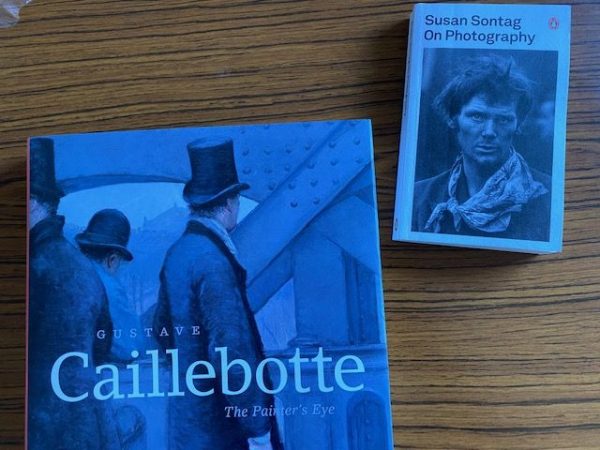
Giselle
Once upon a time, not at the Opera de la Bastille, but next it, in a small theatre called Théâtre de la Bastille, the fairy tale of “Giselle…” was performed. The world-famous ballet Giselle (Karlsruhe Programmheft) is still amongst the most frequently performed magic piece of classical ballet. What is it about? In short: sex and crime. Yes, and it sells well.
Francois Gremaud tells the classic story of excitement, love, deception, death, regret, haunting and memory in a concise and witty fashion. The exemplary dancer is at the same time the narrator of the story as well as the critic and art historian accompanied by a 4 musicians strong orchestra. The educational piece with a “womanxplainer” on stage is great entertainment, full of references, why it is still okay to like the piece in spite of its fantasy-loaded content. Modern dance (Cunningham, De Keersmaeker) has decoupled or emancipated movement from music. In classical ballet, at least, you still know what comes next and this is aesthetically appealing for most people. Besides Wilfried, no he is not part of the “Wilis” (could be an interesting variant), but in the ballet there figures “Hilarion”. He is not hilarious at all. Splendid entries are from Myrtha (close to Martha, but not quite the same) and, of course, Giselle, when she leaves her tomb and turned into a “Wili”. Then there is Albrecht in a pas de deux with Giselle, swirling between earth and space. Aldi dances like mad on impulse from Myrtha, but Giselle vanishes nevertheless. End of story, or is it? Giselle is a Wili and Aldi is the wally. Maybe the story could be retold like in the film “Billy Elliot – I will dance”, which is an emancipatory tale where dance is the liberation rather than part of the dooming fate.
Francois Gremaud with the astonishing performer and choreographer Samantha van Wissen have created a version of Giselle that is musical, aesthetic, funny and critic. For those who enjoy an epic theatre version of Giselle including its “alienation effects”, referring back to Berthold Brecht, will want to read the script as well, kindly distributed as a gift after the show. 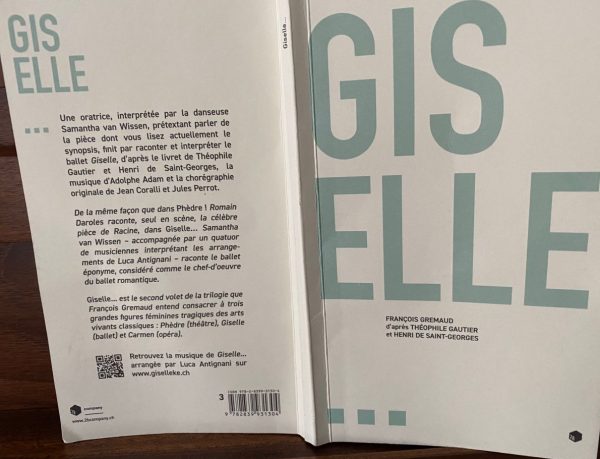
Employment
Employment is back on top of the agenda. Not as we used to think, though. Previously unemployment had dominated societal concerns. Now it is the lack of persons seeking or available for employment. What has happened? The Covid-19 crisis has demonstrated the need of persons qualified to work in the health sector. From health care and urgency care, we are short of personnel in all these fields, everywhere. 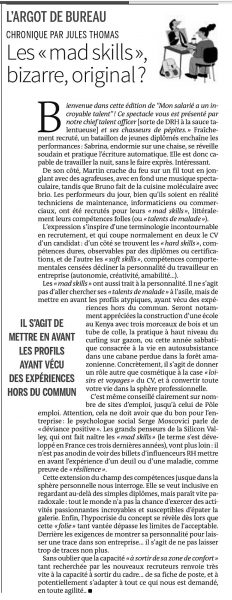 Then we discovered the role of essential services and the need to equip crucial infrastructures like ports, transport, shops, schools and ambulances with service persons resisting despite work overload. Larger cohorts leave employment to retire, some even early due to illness or burn-out. Additionally, war is back in Europe. Military personnel is in high demand again, drawing largely from younger cohorts. The need for conventional weapons. long thought to be oblivious, is forcefully back on the agenda.
Then we discovered the role of essential services and the need to equip crucial infrastructures like ports, transport, shops, schools and ambulances with service persons resisting despite work overload. Larger cohorts leave employment to retire, some even early due to illness or burn-out. Additionally, war is back in Europe. Military personnel is in high demand again, drawing largely from younger cohorts. The need for conventional weapons. long thought to be oblivious, is forcefully back on the agenda.
Growth potentials are everywhere. However, these pre-modern facts encounter a population in the western democracies that insists on new approaches to employment. Beyond hard and soft skills, recruiters seek atypical skills, competences and trajectories. A parachute jump from an airplane, cooking and dining experiences, caring spells, periods in self-employment, all are directly or indirectly relevant for employment and teamwork. So, what is your specialty? Collecting stamps? Surely you are able to spot tiny differences in images with specific content. Fake news and fake image detection or video surveillance is in high demand, just try an application and discover the employment potential of your MAD skills. Sounds crazy? No joke. Skill needs are everywhere, just give it a start again and again. Read a serious newspaper regularly (here LeMonde 19.1.2023) for inspiration.
Sublime
The exposition of art work in the MAD “Musée des Arts Décoratifs” in Paris is sublime. Growing out of fashion design into the work of art can be a process of sublimation: passing from one state of designing one product to producing artwork. The intermediate state of artefacts created for designing a product, like the drawings of fashion designers or scenery and costumes in theatre and operas, are often less visible or subject of exposition. Objects become subjects. A trend in recent expositions is to devote more space to the applied arts like stage design, costumes as well as products of everyday use. “Bauhaus” has a lasting effect.
Elsa Schiaparelli has achieved this sublimation. Starting with extravagant fashion design, her designed fashion objects were adopted by Picasso before she developed into the sublime state of artist with her artefacts herself (see below). Now in this process of subjectivation she is the prime subject of an exposition herself. The combination or arts and crafts (Kunsthandwerk) has been always present in art history. The challenge of concepts combined with arts is more recent or just more explicit since the late 19th and 20th century. Being able to live from your artwork is still a challenge, though due to “Mäzene” and state subsidies it is more feasible to follow artistic trajectories. 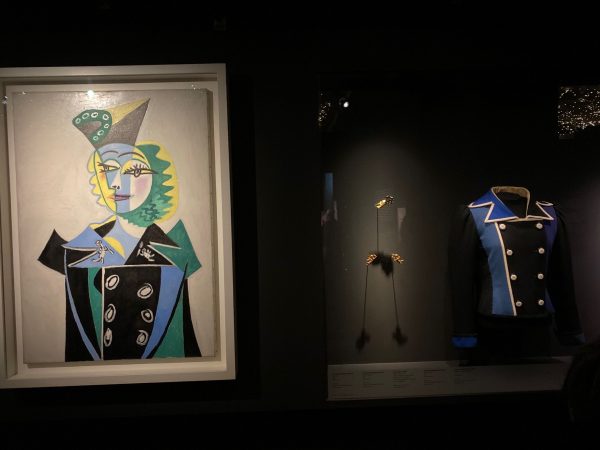
B for Balance
To reach a balance, to keep the balance or one’s balance, this highlights the process nature of balancing. Even the old tool of a balance (scale for weights) very much reflects the evening-out of the balancing process. It seems like a temporary balance most of the time. We might evolve from one level to another one. Especially imagining ourselves on a (body weight) balance in the morning and then throughout the year or years, this appears like a dynamic trajectory. The nature and/or nurture connection is evident. Beware to search for synonyms of “balance” on the internet. You get more than 3000 synonym (Link) meanings and 30 suggestions for definitions (Link) to contemplate on. I like the nice physical experience of balance and the simple (a bit nerdy) explanation of it. Economist get very excited about balance of payments and the ways to achieve equilibrium or equilibria. Balancing personal accounts can be a bit painful at times, but balancing in the arts gets our imagination going. Dancing is about balance most of the time. Playing with your own balance, the balance when 2 or more persons are in action, how not to be absorbed by such experiences. In music, the balance is a primary issue since Bach’s “wohltemperiertes Klavier” and balance and tension are the origin of much jazz. An image or photo might be balanced, certainly architecture is playing with or restricted by balancing acts. Herta Müller’s “Atemschaukel” has thrown us off balance for a while. History we study often with a concern for a balance of power. In peace and war times, the balance of power within and between countries or superpowers are a long-lasting research issue. At times when this balance is at risk or completely out-of-balance we are deeply concerned about the return of a balanced situation. Babies and children draw comfort from being balanced. Adults as well. Let’s try again (chanson). (balance22-venice -video). 
A for Action
The A is everywhere. A is the beginning of the Alphabet, Google is our new Alphabet, we just have not realised it. A simple A-rating in investment is not good enough, AA or AAA is the goal. All this calls for ACTION. Do not be stopped in your action by reading on “Action theory” by Parsons, Rational action is the basis of most economic reasoning before the behavioural turn of economics. It is commonly acknowledged now, that rational action might not always be as rational as we want to believe it is. “Frame selection” as theory to explain our choice of action is fashionable in the social sciences. Transforming values and intentions into actions is a big challenge. Many jokes turn around this issue, like intentions to get up early in the morning. Find out whether you are an actionable leader. You should have at least a few “actionable items” on your to-do-list. Of course, Microsoft recommends actionable items to improve our productivity while spending hours on emails.
Well, early philosophers already distinguished between “vita contemplativa” and “vita activa“. A lot is about finding the right balance here and Hannah Arendt’s differentiation of active life in labor, work and action. She puts emphasis on action as a way to distinguish ourselves from others. The same thought might lead to very different actions. Hence, acting on one’s belief or values could lead to very different policies for just 2 persons. Action Artists perform even in inaction. We are back to basic questions of democratic procedures as a form to moderate between different opinions or possible actions. Lots of other A-words come up now: ambiguity, anxiety, alienation, affirmation, affect, affection. In Greek, A might be associated with Apollo, In German with the famous “Angst”, but French is overriding all this with “Amour”.
Y for YinYang
Y in maths stands for the phenomenon that is to be explained. If you are lucky, it is just one single Y. To explain this phenomenon, we usually have a multitude of different X-es and some random chance element. To complicate things a bit, we have X running over time. Example: Happiness at retirement age (66) might be explained by your earnings over years and marital unions/separations over time plus health over time and other random, not specified elements.
In my understanding of the YinYang philosophy of balancing the complementary of Yin and Yang, I probably should have thrived for a balance of earnings and health throughout my working life, to arrive at a happy retirement. Balancing not only among the X-es, but also between X and Y might even out the excitement about retirement. Additionally, this reasoning leads us to the more complicated case of multiple Y-s and multiple X-es. We can image the optimisation issue of y for 2 persons rather than just 1. Now, the maths starts to get more complicated without being complex in the mathematical sense. If you can solve such equations in statistics using different forms of random and not- so-random error terms, yr doomed for a Nobel medal in economics. What the heck, man this has to do with Yin and Yang? Beware of your work-life balance, be selective, I suppose. Breathe carefully, repair (YoYi) and read up on Chinese philosophy and maybe TCM, short for Traditional Chinese Medicine. Let’s try to re-balance in a lot of life-domains. We know our Western way of life (CO2) is not sustainable. Imagine 1 billion Europeans driving a diesel car on this planet and you have an idea about what hell might be like. An open mind to the Yin and Yang philosophy could be helpful for us, just as much as it would be for the leading Chinese politicians and their policies. Yes, Y in French is much more common than in other languages “Y avait …” is the beginning of chansons (ex 1 Aufray, ex 2 Kaas, portrait). Drawing YinYang using formulas is a bit like drawing or painting mandalas. It helps your inner balance. I am not quite there yet. 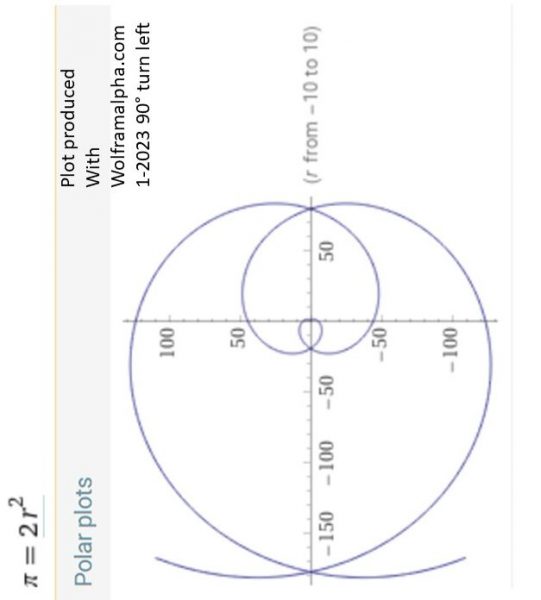
W for War
In Europe many people were lucky to live without the existential threat of war for a long time now. Putin has stopped this with his land-grabbing in Ukraine. We wonder why, what, when and where? War is back in our minds again. Members of the birth cohorts of the 1920s, 30s or early 40s have direct experience our traumatic memories related to war times. Some later born cohorts suffered from various forms of deprivation . Economic reconstruction or even so-called miracles may follow and can soften the traumatic experience, often by way of focusing attention on repair and new investments.
The work by James Hillman “A terrible love of war” has been a difficult read. To acknowledge that “war is normal” and our mindsets should take this into account, is hard to accept. Hillman cites Susan Sontag to state that “we cannot imagine how terrible war is – and how normal war can become”. We need a leap of imagination (p. 9) to grasp the mythical element about war which seems to be beyond the rational understanding of it. Greek tragedies told us, all along for more than 2000 years. The Romans exceled in it and German perfectionism and cold-bloodedness added the most horrible recent experience of war for millions of people. Memory and historical knowledge are important to activate recall for older and learning for younger generations. (short Video clip on war and UKR)
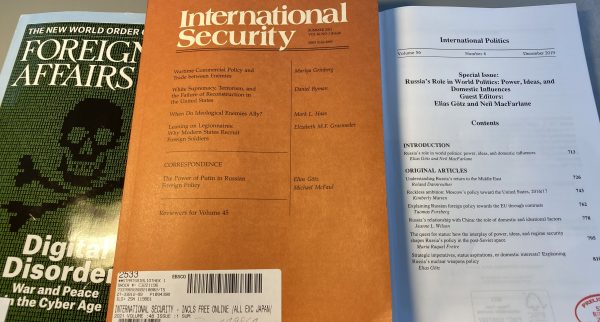
T for Time
“The times they are a changing“, end of blog entry T.
We live time forward, but we seem to understand it only backwards or in retrospect. Towards the end of each year, it is common practice to look back and review the last 12 months. Then we imagine what will the future be like. Our concept of time is past, present or future oriented. In classical physics we reflect this with a depiction of time on a linear axis. However, modern concepts of time include Einstein’s relativity theory, whereby in 2 different places time may run with different speed. Similarly, quantum physics allows that the causal relationship between 2 physical states is no longer observable in a logic that follows linear time. A particle may exit in 2 states in parallel. Hard to imagine, maybe, but demonstrations of these effects are found in textbooks for pupils already. Our grasping of the world around us is enhanced through scientific rigour.
Story-telling also plays with time frames. Analepsis and prolepsis are common techniques constructing a story, a film or any form or narrative. We tend to perceive chronological time even as boring. Our memory is also playing tricks with us on time scales. When was …? Additionally, we have multiple clocks ticking away. Time to submit a report, pay taxes, until the next medication or the psychological concept of “time until death”. Strangely enough, depending on which ticking clock we focus most, our behaviour is likely to change. Mobile time management tools have been created for centuries for us to handle all this jazz (call them a watch). They all have not changed our concept of time, only the precision to measure and cramp more activities or the same one faster into our daily life. Happier since? Test your self-efficacy, more general than time management! Try meditation to slow down the pace, use an app!? I started to clone myself with a virtual presence to experience the quantum effect of my life. Podcasts are played with 1,5x the normal speed now. Rhythm and music are the remaining traditional metrics of time. Even there, John Cage’s piece “silence” managed to abandon the time reference, partly at least. Okay, time is up, next letter, please.
S for Society
At least since the “Greek Polis” became a subject of science, the study of society has filled libraries around the world. To catch up with the social sciences view on society, we may start with foundations based on Max Weber, Niklas Luhmann, Jürgen Habermas, Ulrich Beck to then move on to my predilection with micro-level foundation of social theory based on work from James Coleman. The history of sociological ideas runs from the protestant work ethic, autopoiesis in systems theory, ethics of discourse and communicative action, risk management to “1 to 1 relationships” as pillars of theorising about society. 10.000 pages later on, you might still ask yourself the question: what practical knowledge have I gained from this. Well let’s see. Imagine you want to learn about a friend and whether s/he is really a friend. Nowadays we would start with an online-search to find profiles of a person (facebook, Instagram, linked-in, twitter, twitch, mastodon). When the first entries pop-up, we start to learn about interests, looks, friends and preferences of the person. In which social media the person is (or not) participating tells a lot. We start to build an image of the person and her/his networks and communities. Soon we start comparing the person’s world reference framework with our set of values and characteristics. Welcome to thinking about society in small, and interactions within society or between groups of society. Adding some solid knowledge about statistics and you’re ready to start the science of society.
Yet, so many still open questions. When talking about society, we have to think about the trend of individualisation and ways to keep society together despite increasing plurality of life courses. “Solitude versus loneliness” is as much a social as it is an individual based issue. Community-building with inclusion, staying-on and exclusion processes have to be studied in detail. The whole process of civilisation or the study of suicide has been a sociological topic since its inception by Emile Durkheim. Imagineering is an additional tool to speculate in a systematic way about the past and future of society. That’s where all the arts come into the picture as well. The history of art is full of perspectives on society, its splendour, the misery of individuals, communities and societies. An emotional starting point is a very valid starting point, the science of society then moves on to abstraction and generalisations as well. The challenge is, to capture audiences emotionally, with short reflections on society. 
R for Repairing
Without noticing for many people, we have shifted into the repair mode. Our planet needs repair work. Well beyond the less plastic, CO2, less oil, gaz and pollution in general, we have to actively repair what we have damaged, certainly since the industrial revolution. With nuclear waste we have entered into a phase, in which repairing is not really feasible. Areas around Tschernobyl and Fukushima speak for themselves. However, we seem to leave the repairing to future generations. Whereas for us currently it is an option, later on it will be an obligation.
The bionic interest has already turned to the Axolotl and Polycarpa mytiligera. Both species can repair themselves after the loss or a malfunctioning part of their body. Rather than producing externally, growing the spare part is a promising healing device. Nature provides many fabulous insights, if we were able to preserve the biodiversity. Repairing biodiversity is difficult, impossible for lost species which we do not even really know. Start to repair and build awareness that repairing can be fun. Beyond the gender stereotypes, women repair cars, men repair clothes, we have to learn from each other how to use our repair knowledge for many other things and devices. This applies even to our social, legal and economic systems.
In addition to reimagining, we need repairing everywhere. I have lots of stuff to repair at home. When do you start repairing? Welcome to the next trend: the joy to repair, repairs even joy. 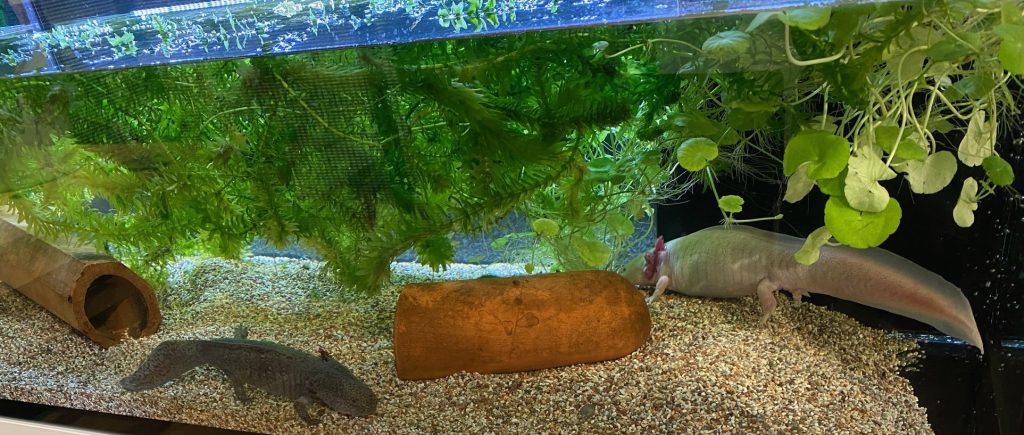
Q for Question
Quality and quantity or queer and query could have made valuable entries here as well. Common to all is the underlying process of questions. Questions put to oneself, to others, society or supra natural or supra national instances. Can quantity turn into quality? Is a queer perspective a new one? Is a query in a programming language the beginning of each algorithm? Questioning is a child’s “natural” approach to understanding the world. This does not stop soon after childhood, but it is occupying, if not haunting, us until the end of our life. When is this exactly happening – the end thing? Are we free to chose this? Just try to answer one of these questions and you’ll find out how one question leads to the next. We are all the same in this behaviour. However, we all find different stopping rules to the query algorithm. Religion is a fast shortcut to stop further questions. Sciences are the never, ever, ending type of questioning. Mathematics solved part of the problem. For a lot of series we are able to calculated the limit value towards which the series evolves circumventing the lack of a stopping rule. Fundamental human rights are such a far-reaching stopping rule. Just like after the French revolution, the question was, how to quickly spread the message of human rights. Didactic and paedagogics evolved in parallel. From “cogito ergo sum” to “rogatio ergo sum”. 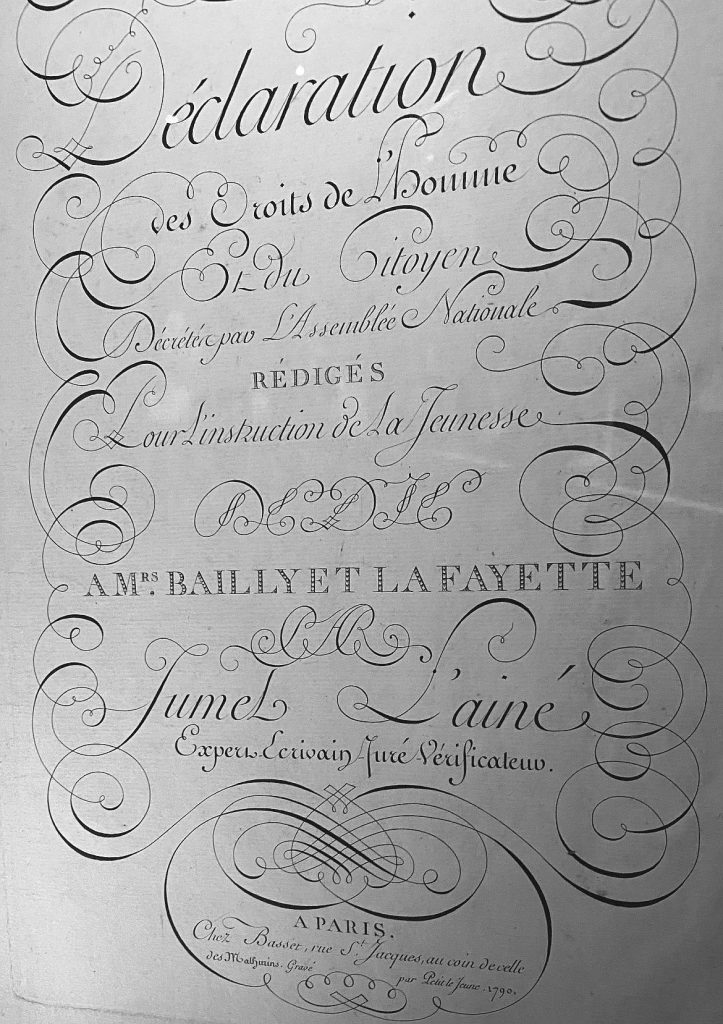
P for Policy
Politics and policy are key elements of democracy. Agreeing that we might strongly disagree, is a virtue of democracy, particularly in order to avoid a confrontation using force. Dialectic thinking builds on the confrontation of opposite opinions originating even of the same factual knowledge. Based on different theories the same evidence will be interpreted differently. Hence, in the field of politics, where disagreement is part and parcel of the game to build majorities, policies will change. This then leads to the belief that we need a policy in each and every subject of the alphabetical list we are about to create. There is a high risk, if you are not having a digital security policy, you will be at high risks that crucial infrastructure might not work in case of a major internal or external conflict. Candide in his small garden might run out of water to water the plants or climate change is threatening the species growing until recently. Young startups, just like ageing enterprises, persons or societies need a policy to take care of survival, not only of the fittest. As the challenges and stakes of humanity rise fast, a revival of the policy sciences is dearly needed before the pervasive skill shortages creap into the fields of social sciences as well. 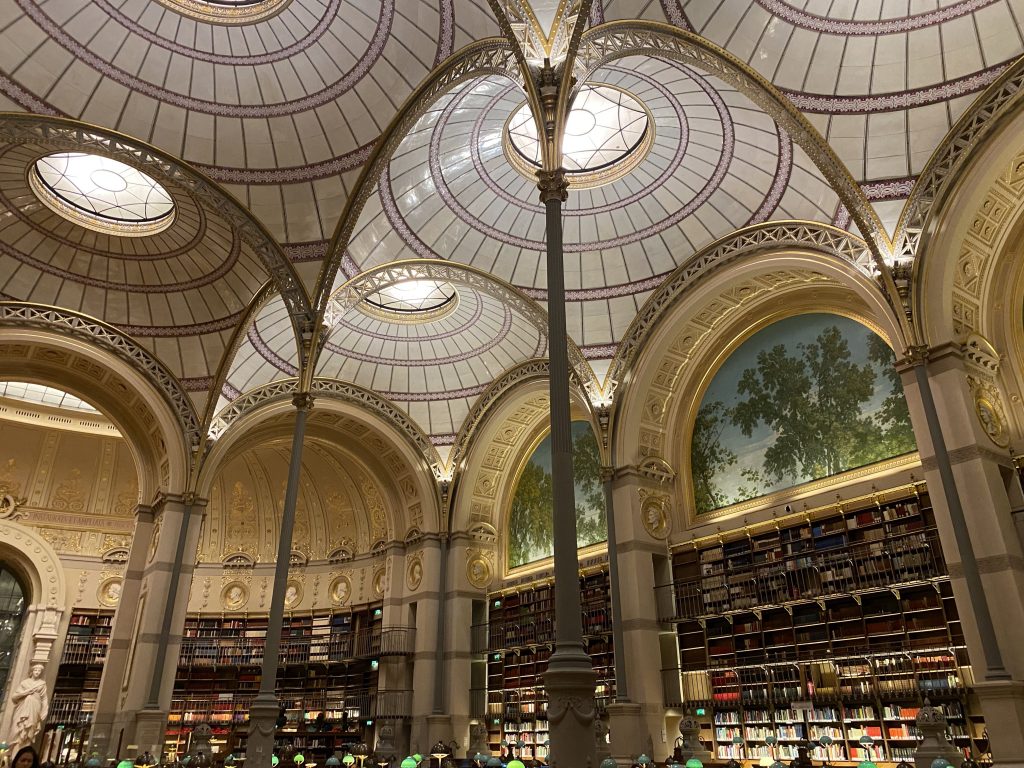
O for Optimism
Looking back at the end of every year to what happened in the last 12 months gives mixed feelings in annual repetition. Developments of nature and biodiversity are sometimes troublesome (variants of viruses like omicron). Despite wars and man-made disasters most people have a capacity to bolster with optimism. To view a glass as half-full rather than half-empty is a common description of two different perspectives on the same fact. Additionally from a longitudinal perspective it matters, whether you started from a full glass beforehand or from the empty glass. In experiments we would need to clarify the role of the starting point and evolution before the statement on the 50-50 state of affairs.
In the French enlightenment, represented by Voltaire‘s “Candide ou l’optimisme“, a critical view on the optimism of Leibniz is expressed. The optimistic claim of Leibniz, “we live in the best of possible worlds” is questioned by Candide who believes taking care of his own little garden is probably the best he can do to preserve nature and the world. These two apparently opposite perspectives and conclusions on the potential of human action we find reflected still nowadays in politics and world affairs. Do we stand up to defend human rights or do we believe the fight is futile? The optimism embedded in Ukranian culture, for example, demonstrates the power that might come out of optimism. It would even go as far as stating that optimism is a precondition for democracy, always striving for the improvement and spread of democratic procedures. Creating opportunities to more freedom to do something is the driving force besides ensuring to curb infringements on one’s freedom. Optimism is a close ally of imagination, imagination of all people living in peace. A nice sunset gives hope for a nice sunrise as well.
N for Nature
The first association with nature for me is the nature surrounding my childhood. Rivers, forests, vineyards, mountains. Maybe a little bit of German romanticism surrounds this. I still enjoy occasionally listening to some nature romantic songs (Lieder) from Schubert, Schumann, Flotow or Mahler. Beginning with adolescence natural sciences took over, but what does natural really mean in the natural sciences. In the “Encyclopedia Britannica” the term natural has already been dropped. What has been referred to as natural sciences is just found under the term sciences. The social sciences or psychology are not included under entry of sciences. One of the high reputation scientific journals is still named “nature”. Only a small fraction of the papers deal with what ordinary people would associate with nature. The nuclear fusion or nuclear energy research and applications in practice figures still prominently in there. Ever since Tschernobyl, Fukushima or Hiroshima, horrific dangers are associated with nuclear energy. The power plant of Saporischschja in Putin’s war, dominates public concerns in 2022. The natural sciences frequently are certainly not researching in the interest of nature. Hence, the social sciences need to deal with the social consequences of (natural) scientific advances. Science and technology have an intrinsic link to each other.
The loss of biodiversity is the most obvious demonstration of how cruel our own species is towards any other form of live. Not only is demography reminding us that with 8 billion of us we might further contribute to our own overpopulation, we might sooner or later destroy the whole planet either slowly with polution or through weapons of mass destruction. Poor nature, instead of pure nature is our destiny. Our western lifestyle is not sustainable and we have no right to impinge on the rights and resources of future generations of us or those who have not poluted the planet like us in other parts of the world. So, when did it all start to go wrong? Probably our creed for more of everything has been nurtured for far too long. Less is more has to replace it somehow. This is also part of our nature. 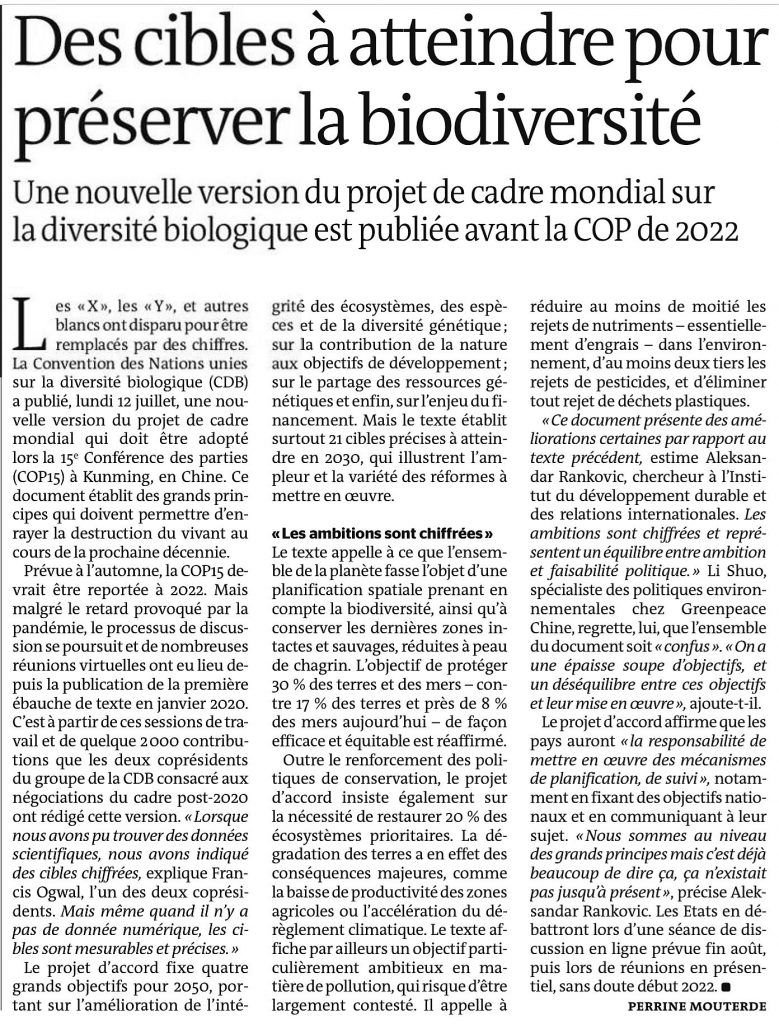
M for Memory
Besides the English term memory, which refers to a huge scientific literature starting with cognitive psychology, I like the French version of “mémoire”, because it is more comprehensive with additional meanings, nicely represented by Wikipedia.org. On the German Wikipedia-page you find first the reference to the children’s game memory, turning around images and memorising where the counterpart is/was (play pairs). This diversity hints towards a cultural element in memory. There is a person’s memory or mental capacity to recall and ways to remember. The latter term refers a lot more to collective memories and becomes a more debated issue. Danny Trom uses the term “split memory” in a chapter on France and the “myths of nations” (p.129-151). In David Brook’s reader on “the social animal” he states that grandmasters in chess (p.88) were long believed to have superior memory. This is actually not true as memory experiments showed, but they rather saw formations and “internal connections forming networked chunks of information”.
“Mémoire”, on the contrary, refers also to the writing of a person’s own biography. Nowadays, book shops contain whole sections of autobiographies, the most sold appears to be the one by Michele Obama recently, if I recall correctly. Among the most scandalous is the publication of the “Journal pour Anne (Pingeot) 1964-1970” by Francois Mitterand. All the autobiographical documents make explicit major parts of what might form collective memory later on.
Memory has found its way into engineering and computing. The memory effect in batteries or being “out of memory” frightens users in computing or programming. In short, I wish you the best of memories reading this page and stimulation by visiting memorials (image: Jewish Museum in Berlin 2022, Ullmann exhibition). 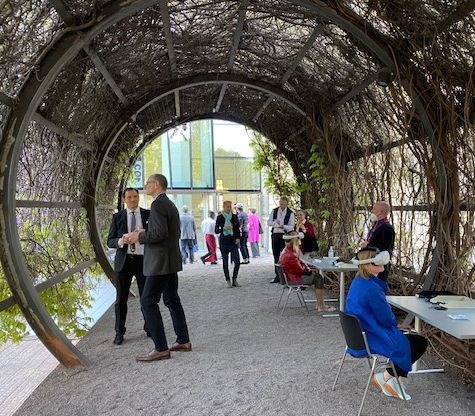
K for Knowledge
Readers of the sociology and/or the philosophy of science or knowledge have a hard time. Each discipline is evolving at such a high speed that is terribly hard for humans to follow more than 1 or 2 fields. Perhaps the choice of Karma instead of knowledge would have made it easier here. Alternatively, in German it is easy to find many nouns starting with a capital K. Kapital, Krieg, Kritik or Käsekuchen would have been popular, I guess. Soon I shall open the comments for suggestions for additional nouns, as part of the empirical “swarm knowledge strategy” rather than the theory-driven deductive method applied in knowledge generation on my side so far.
But wait, we are already in the middle of the unsatiable quest for knowledge. On a meta-level we would deal with the multiple ways to acquire knowledge and create new knowledge. Artifical intelligence is certainly one of the hypes at the moment. New data and new combinations of data drive us forward in the expanding universe and knowledge space. We have witnessed the disappearance of the thick printed encyclopedia in most households, replaced by specilised digital dictionaries or the network society’s shared knowledge base of “wikipedia“. Knowledge is linked to the history of ideas and Peter Burke is a prominent figure to rely on as a reference in this field. 20 years after “A social history of knowledge: From Gutenberg to Diderot” he published the much acclaimed: “The Polymath. A cultural history from Leonardo da Vinci to Susan Sontag” in 2020. To synthesise across the many “monsters of knowledge” over centuries is a daunting task. I like quotes like the one from Leibniz (p.77) “the horrible heap of books that is constantly increasing” and then his own continuation: “Printing, once viewed as a solution to the problem, had become a problem itself”. The whole section is devoted to information overload. Fragmentation of knowledge into disciplines and, much worse, the manufacturing of false knowledge create new challenges to knowledge. Maybe transforming the term to “knowledges” rather than knowledge is likely to capture better the differences between artificial knowledge, created by artificial intelligence and specialised algorithms, and human based knowledge. In knowledge storage we have lost the race with computers, but in deciding what are promising combinations between different fields of knowledge, we are still a wee bit ahead of the machines. Klara tell me, where is the exit, or your synthesis of the whole lot. Meanwhile I continue to read – what? books and the like. 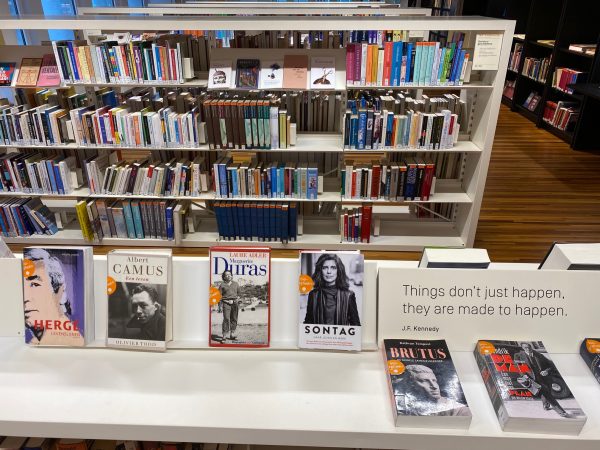
J for Joy
Talking about joy is fun. Its feels better than just cracking a few jokes, and this is not bad at all. The starting point of much joy can be a simple joke, because of the simplicity of emotions and the bonding between persons. However, laughing about jokes is often abused in the form of laughing at the expense of someone or a specific group of persons (serious publication “L’empire du rire” CNRS, 998 pages). This explains to me the difference between a joke and joy. Joy is the emotion resulting of a joke, but also of many other experiences. The simple joy to meet another person, an animal, the sun, rain, wind, music, art or just less pain is more probably more intrinsic. To receive or to give a present is often associated with a joyful moment, sometimes lasting quite a bit. For some psychologists, emotions can be problematic, if a person can no longer regulate them effectively. Many persons tend towards excessive use of alcohol or other drugs to experience positive emotions like joy. Negative emotions of another person, strangely enough, may also contribute to the joy of another person (“Schadenfreude”), e.g., if a dictator is finally overthrown.
Much more inspiring is joy in connection with religion. As a critic of religious ideas, the attempts of religion to define joy for individuals and society probably explains the success of religions. Representations of Buddha, show the happy or joyful monk, Christians define joy with the advent and the birth of an unconceived child, fighting fiercely any modern forms of contraception and science advances for birth assistance. Restricting jokes and joy to the “carnival” period reflects the Christian doctrine to control and monopolise the definition of joy. Therefore, it is no surprise to witness that many persons feel more inspired by Asian traditions like “Ikigai” or “yoga” in their daily routines to experience joyful moments. I always found it very odd that Christian fundamentalists would not say Merry Christmas before the 25th of December after they have been to church at midnight. The priest or pope as the master of joy is a very strange idea. Affect inhibition or deferral is a powerful psychological tool. As in this blog entry I deferred my joy and laughter until the last line. So now, please join me in a wholehearted JOYFUL LAUGHTER, so the people around you may believe you’ve gone completely mad. It might be the beginning of more lasting joy, just keep practicing. Joy is within us not depending on outside stimuli, joyful1 although they might help. 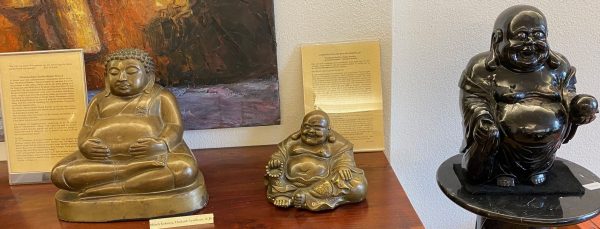
H for Health
Health is not just a personal issue. Of course, in modern times most people are primarily concerned with their very own health. Particularly, if pain is involved, we tend to put ourselves first. Only various religions and ideologies put God or some other bigger thing, for example identity, in front of personal pain. This bigger thing is believed to decide wars, like Russia trying to anihilate Ukraine. Russia’s military agression stands against the fight for freedom, democracy and perpetuates corruption.
At the beginning of the Corona-Crisis most persons and societies still believed health and infections are only a very personal issue. Researchers with knowledge about “public health” knew already, viruses have accompanied humanity since its beginnings and maybe continue to do so even beyond our disappearance. Hence, addressing the topic of society and health from a public health perspective has become much more popular as prevention is key to fight pandemics as early as possible. However, for prevention to work you have to involve and rely on individual behaviour. As soon as we leave the personal issue of health, we have to address a whole set of other topics like patient – carer relationships, cooperation, interdisciplinarity, public expenditure, public-private partnerships, corruption or behaviour of large crowds. We have developed antidotes against most difficulties, probably the strongest one is solidarity. Social systems that address inequality of provision (e.g. between regions) or inequality in access to and quality of medical services (e.g. doctors, care or pharmaceuticals) have a strong role to play. Structural, financial and political issues play a powerful role in health. As we think more about prevention and costs we start to understand that we have to start with nutrition, mobility, mortality and our western style of life in more general terms, particularly if we think about health on a global scale. There is no planet B where we could travel to, once it has become impossible to lead a healthy life on our planet. Topics of health over the life course or ageing will need a lot more attention. Findings on the risk of suicide after onset of physical health problems (Link to study) asks for fast responses. Access to digital tools might be part of the solution like “Sympatient” as well as being part of the problem like data leakage. 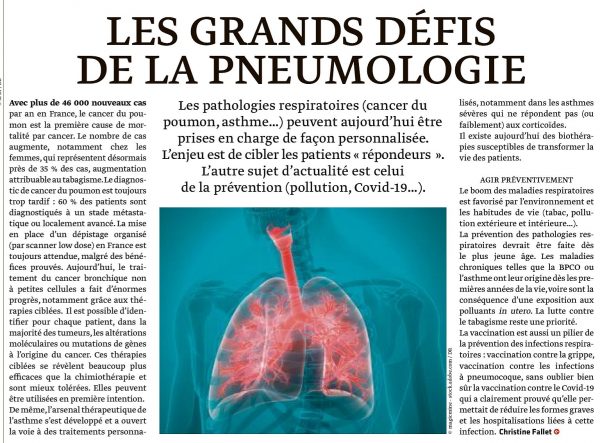
E for Enterprise
There is a new start-up scene in development in Germany. Interesting to witness the new entrepreneurial spirit. Many of the youngsters grow out of their peer community, wanting to try new ways of working and living together. The new bottom-up or grassroots form of growing a business out of a subculture seems to be an adequate response to the growing diversity of societies and easier ways of community building through online social media. Name it “reach” today, it is similar to what you previously called having a customer base. The new element refers to a blending of cultures. Learning through being online connected to the world, yes, the whole world, allows wide-spread influences from other sub-cultures, be they American, Asian or African. The young are open-minded to new stimuli like “Ikigai” from Japan and, of course, the life histories of founders and individual biographies from entrepreneurs like the legend of Steve Jobs, Apple’s legendary founder. Imagineering has become part of the movie-influenced influencers. Short clips out of a longer story build communities. The witty comment, like at school, gets more attention than the long boring story of the preacher, teacher or the mansplainer. The experience of “flow” is all around these communities and this creates the specific magic of the start-up scene. They take each other to new levels, mutually, reinforcing their preferences and life-styles. They are well aware of the risks they are taking. “Keinhorn” German short for “not an Einhorn”, the one billion value threshold for super successful enterprises taught them crucial lessons. The “ecology of organisations” which I referred to in my courses at the now renamed “Constructor University” previously “International University Bremen”, then “Jacobs University”, (let’s see what comes next?) is an important complementary research tradition to assess the “survival” of enterprises. I still recommend this University, which I quit to start new endeavors. It carries in its several  “names” the important message:
“names” the important message:
start, fail, change, (repeat). 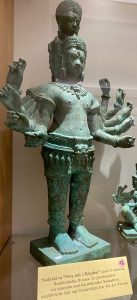
Marx-Wagner
Begleitend zu den Ausstellungen zu Karl Marx und Richard Wagner fand eine vom DHM organisierte Vortragsreihe statt. Die Links (hier) zu den Hördokus sind eine anregende Erweiterung der Ausstellung und stützen die These der Verbindung zwischen Karl Marx und Richard Wagner auf einer abstrahierenden Meta-Ebene. Die Vorträge, Gespräche und Diskussionen informieren und vertreten wissenschaftlich fundierte Thesen. Die müssen gerade nicht von allen geteilt werden, aber eine Haltung zu dem Thema haben die meisten Menschen in der Welt, besonders wenn wir an die Millarden von Menschen jenseits von der westlichen Welt denken. Es ist also auch an uns, diese Diskussion über den Kapitalismus zu führen. Hören wir mal rein. Alle dauern 1h-1.30h!
Einleitung, M&W Kosky + Bisky, M&W Nietzsche, M&W Mahatma Gandhi, M&W Viktoria Kaiserin Friedrich, Ein Artikel aus der Financial Times von Martin Sandbu vom 18.8.2021 und Martin Wolf vom 21.11.2021 ergänzen die Diskussion: Wenn der Kapitalismus weltweit gewonnen hat, was war dann noch mal der Wettbewerb? Bitte öffnen Sie jetzt ihren Computer, Sie haben 3 Stunden Zeit für die Beantwortung. $???$ Danach speichern Sie bitte das Dokument in der Cloud und nehmen es zur Evaluation nach 10,20,30,40 Jahren wieder hervor. Hat sich ihre Meinung über den Sachverhalt zwischenzeitlich verändert? THX for your feedback. 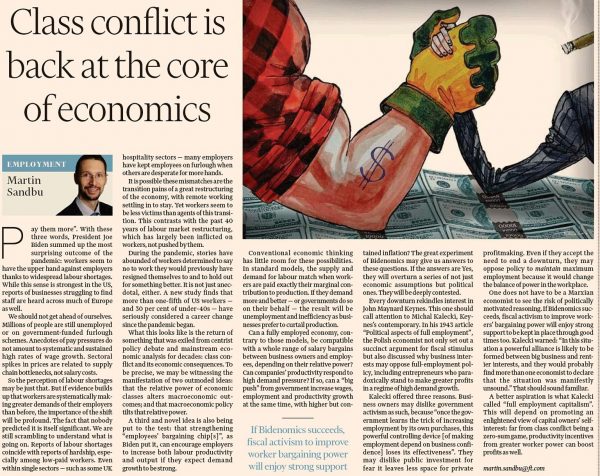
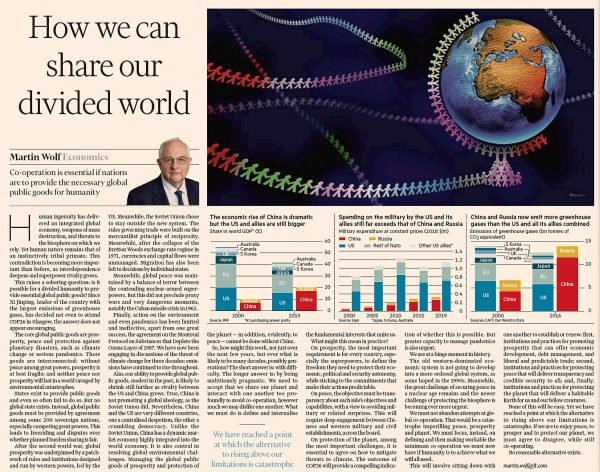
China altert
Zurückgehend auf die frühere strikte 1 Kind Politik erhöht sich der finanzielle Wohlstand der Chinesen alleine dadurch, dass das gleiche BIP auf weniger Köpfe verteilt werden muss. Eine Generation später ergibt sich aber durch das rasche Altern der Bevölkerung eventuell ein hohe finanzielle Last für weniger Beschäftigte bei gleichzeitig mehr älteren Menschen. Die Beschäftigungsquoten der älteren Menschen waren niedrig im Vergleich zu Europa, das bedeutet ein gestresstes System zur Finanzierung der Renten und, wie eine neue Studie (Lancet Public Health 2022) zeigt, für die Pflege der Älteren. Bis 2030 werden laut der Studie bis zu 14 Millionen Menschen zusätzlich Pflege benötigen. Das betrifft überwiegend Frauen und Personen im ländlichen Raum. Das ist bei uns auch so, denn Zugang zu ärztlicher Hilfe, Krankenhäusern und Unterstützung im täglichen Leben ist aufwendiger bei größeren Entfernungen und Fachkräftemangel. Das Ausmaß der Pflegebedürftigkeit hängt stark von dem gesunden Altern ab. Dies ist wiederum vielfach bedingt durch Bildungsniveaus und Lernfähigkeit und -wille im Alter bezüglich der eigenen Gesundheit. Bewegung ist der Schlüssel zu mehr Gesundheit. Damit lässt sich die Pflegebedürftigkeit lang hinauszögern. Also raus, auch wenn es frisch ist. Open access Lancet paper (hier) 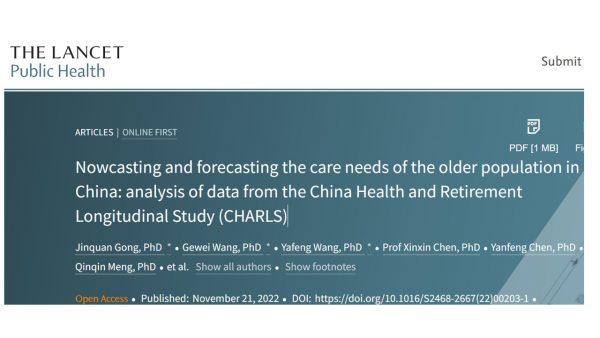
Ident
Wir alle kennen mittlerweile das Ident-Verfahren. Meistens begegnet es uns bei Eröffnung von Konten durch ein Post-Ident-Verfahren am Postschalter oder durch ein Video-Ident = Identifizierung per Video oder Uploads von Fotos des Personalausweises bei irgendwelchen Portalen. Praktisch ist die gemeinsame internationale Sprachwurzel Ident-ität, -ité , -ity in D/F/E. Unsere emails funktionieren mit einem eigenen, vergleichbaren Ident-Verfahren. Die meisten Menschen hinterfragen nicht weiter ihre Identität bis sie von anderen oder von außen darauf hingewiesen werden. Bei Reisen jenseits der EU wird staatlich verbriefte Identität, meist mit Nationalität gleichgesetzt, dann zu einem Thema. Regionale Identitäten innerhalb eines Staates sind auch ein leidenschaftliches Thema bei Fragen zur Herkunft.
Der Autor Paul Audi hat in seinem Buch zum Thema “Identité” eine der modernen soziologischen Literatur entsprechende Sichtweise auf Identität vorgestellt. Nicht eine, sondern mehrere Identitäten, eine an sich plurale Identität ergibt sich in der modernen Welt mit verteilten Loci der Identität. Das hat Roger-Pol Droit in seinem Editorial von LeMonde des Livres vom 26.8.2022 treffend zusammengefasst. Sicherlich eine viel und kontrovers diskutierte Anregung in Wahlkämpfen. Vereinfachung auf Pass = Identität greift viel zu kurz. Identitäten schreiben Lebensverläufe sowie umgekehrt aus den Lebensverläufen Identitäten entstehen. Teils gemischte, teils neue Identitäten sind dabei im Werden begriffen. Sie sind selten statisch, meistens eher dynamische Verläufe mit komplexen wechselseitigen Beziehungen. Konstruktion, Dekonstruktion und Rekonstruktion sind das was bleibt. Spannende Biografien eben. Eine Fixierung der Identität auf etwa zufällige Herkunftskonstellationen verkennt die Chance Identität als Ziel selbst zu definieren. Daraus ergibt sich ein erweiterter Freiheitsbegriff. Sich eine neue berufliche Identität zu konstruieren, gehört zur Entwicklung von Jugendlichen und mit lebenslangem Lernen gleichfalls zu Lebensverläufen von vielen Menschen. Warum vor Grenzen halt machen. Bilaterale Identitäten (z.B. D-F) gehören zum Alltag. Eine europäische formiert sich (proposition en francais). 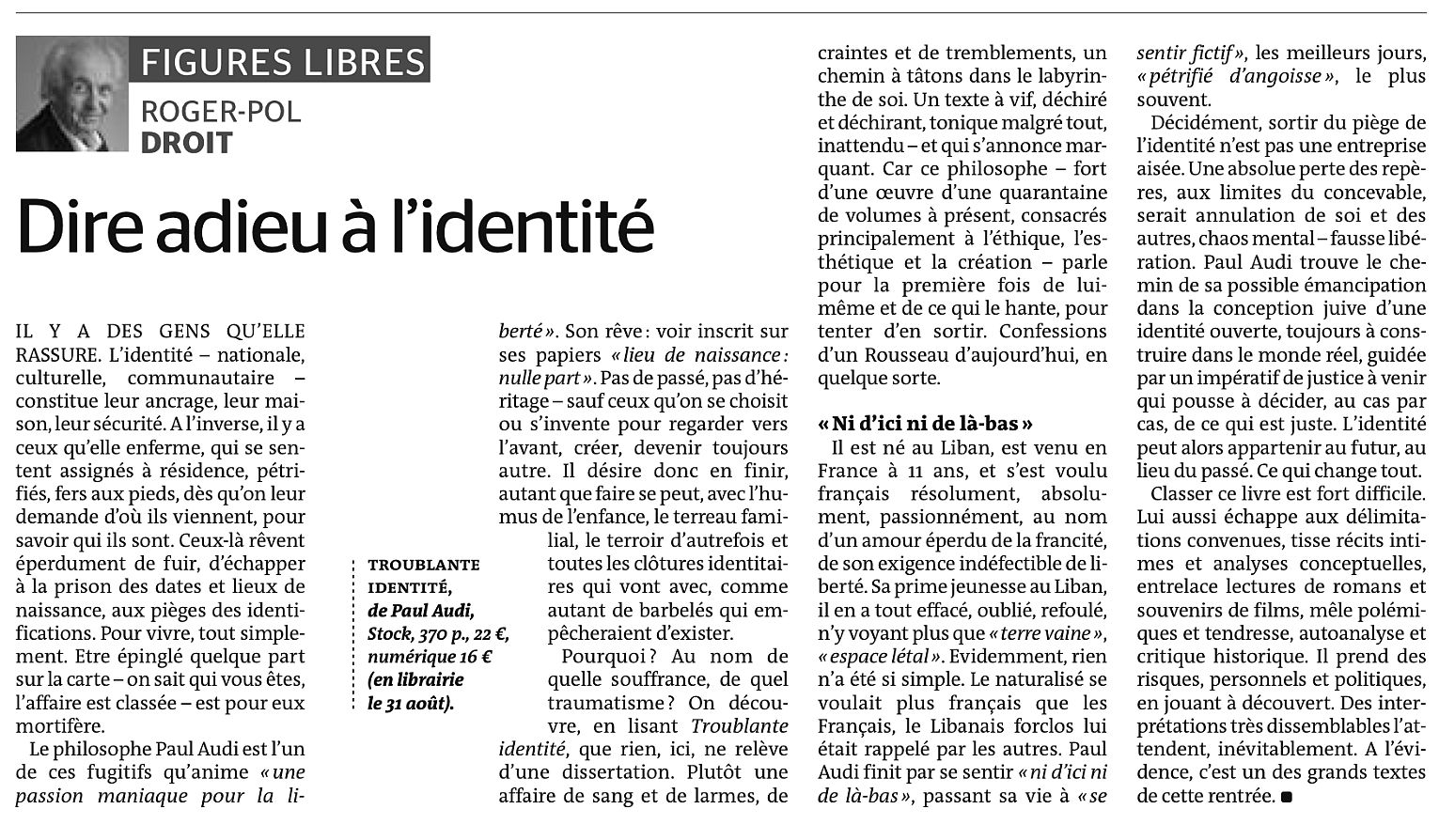
Lange Schatten
Bestimmte Ereignisse im Leben von Menschen werfen lange Schatten. Das ist ein viel beforschtes Thema (z.B. critical life events research). Einen frischen Blickwinkel aus autobiografischer Perspektive ergänzt Andreas Fischer mit seiner autobiografischen Erzählung “Die Königin von Troisdorf“. Er steht buchstäblich im langen Schatten seiner Großeltern, Eltern, Tanten und Onkeln. Mit viel Details widmet sich der Autor den Nachwirkungen von Kriegserfahrungen seiner Familie, hauptsächlich denen des 2. Weltkriegs auf die Psyche. Das Schweigen zu den oft traumatisierenden Kriegserfahrungen schafft neuerliche Barrieren, die in die Gegenwart fortwirken. Verbindugen zwischen den Generationen lassen sich erzählerisch gut darstellen, insbesondere das Sich-ineinander-verschränkende der Beziehungen und Erfahrungen. Dabei gibt es Kernschatten und Halbschatten, aber selten klares Licht auf Geschehnisse. Einzig die langen Nachwirkungen werden offensichtlich. Dabei könnte anstelle des Schweigens der Generationen zu den eigenen Erfahrungen und denen der (Groß-)Eltern durch Berichten im Familienzusammenhang vorzüglich als Lernkontext für alle und nachkommende Generationen dienen. Nach den vielfach gescheiterten Aufklärungsversuchen der 68er- Generation, hatte sich eine neuerliche Schweigewelle ausgebreitet, die erneut zu brökeln scheint (vgl. Henri-Nannen, vielfach Straßennamenänderungen). Bis zur Kriegswende 1942 wurden große Pläne geschmiedet (damals schon in Verbindung mit einer Besetzung der Ukraine S. 215-6). Das nachwirkende Trauma besteht wohl neben den vielfach beschriebenen direkten Kriegsverletzungen auch in dem Zerborsten der euphorisierten Zukunftsträume der Kriegsgenerationen aller Altersklassen. Aus Kindheitsträumen wurden offensichtliche Illusionen oder gar tiefsitzende, externalisierte Enttäuschungen. Verdrängte Schuldfragen und Wahrheitsverweigerungen mussten über Jahre aufgearbeitet werden. Die abgekürzte Entnazifizierung hat die Länge der Schatten innerhalb der Gesellschaft und der Familien nur vergrößert. Halbschatten ist eben nur halb im Schatten und schon halb im Licht. Bildquelle: http://didaktik.physik.hu-berlin.de/material/forschung/optik/anfangsoptik/schatten.htm
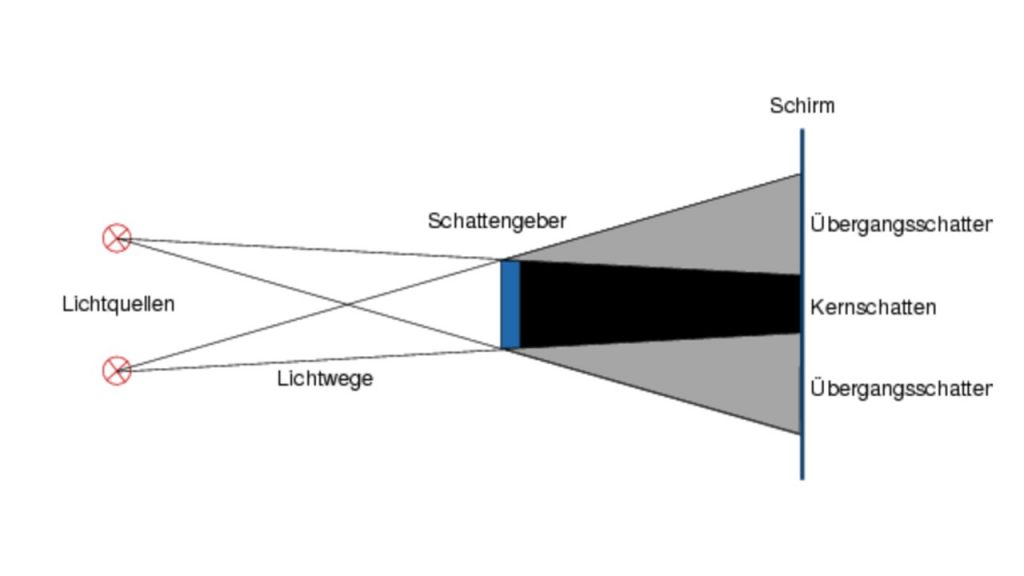
Chopin + Sand
Frédéric Chopin und George Sand erschufen ein Lehrstück zum besseren Verständnis des Mäzenatentums. Die Autorin und Zeitungsverlegerin George Sand hat es Chopin ermöglicht, sich auf den Landsitz im Sommer zurückzuziehen und sich fern der Hektik von Paris auf das Komponieren zu konzentrieren. Chopin‘s Frustration über die 1837 aufgelöste Verlobung, die der Vater der Geliebten initiiert hat, hat sicherlich der Gesundheit und psychischen Verfassung des Komponisten einen weiteren Schlag versetzt (Ganche & Saint-Saens, 1913). George Sand kannte Chopin seit dem Abend, an dem sie Chopin in einem Pariser Salon Franz Liszt vorgestellt hatte. Hinzu kam die Ermöglichung in der Nachbarschaft einer Wohnung am Place Pigalle (Montmartre, Paris) eine preiswerte Untermiete bei derselben Gönnerin zu beziehen. Die in Polen lebenden Geschwister und Verwandten von Chopin haben sich persönlich bei George Sand bedankt und die Notwendigkeit erwähnt den mit Tuberkulose ringenden Musiker, der zusätzlich eine Tendenz hatte in Traumwelten abzudriften, mit Entscheidungshilfen beizustehen (Ganche, É. & Mercure de France, 1935). Diesem nahezu elterlichem Ansinnen auf nicht nur finanzielle Unterstützung, sondern auch psychologischer Begleitung wird die Schriftstellerin gut 7 Jahre lang gerecht. Die Aufenthalte auf dem Landsitz Nohant (région Indre ) werden für beide zu einer fantastischen Inspiration. Continue reading “Chopin + Sand”
George Sand
In der Reihe der bedeutenden Mäzeninen sollte George Sand nicht fehlen. In dem Buch “Les étés de Frédéric Chopin à Nohant 1839-1846” wird die Rolle von George Sand deutlich, wie sie Frédéric Chopin neun Jahre lang in ihrer Villa auf dem Land empfangen und seine Kreativität und Gesundheit unterstützt hat. Eine Liebesbeziehung war Teil der Komplizität der beiden Romantiker. Schriftstellerei und Komponieren haben sich vortrefflich ergänzt. Die Liste der Werke für Klavier, die in Nohant von Chopin komponiert oder fertiggestellt wurden, beläuft sich auf fast 50 Stücke. Mazurkas , Nocturnes, Walzer und Polonaises. Das Buch enthält vier CDs mit diesen Werken interpretiert von Yves Henry am Klavier. Als Camille Saint-Saens mit elf Jahren 1846 sein erstes Konzert im Salle Pleyel in Paris gab, war Chopin bereits sehr krank und hatte nach der Trennung von George Sand noch 3 weitere Lebensjahre. Musiktheorie “Harmonie und Melodie” von Saint-Saens beinhaltet Innovationen, die auch auf Chopin basieren. Jahre der Mittellosigkeit betrafen den jungen Saint-Saens und Chopin in seinem letzten Lebensjahrzehnt. Mäzenatentum daher eine “condition sine qua non” im Schaffensprozess. Die politisch, feministisch, sozialistish engagierte George Sand, die eine Regionalzeitung “l’éclaireur de l’Indre et du Cher” aufbaute (1844) schreibt charakteristisch für die RomantikerIn in dem Brief an die Mitgründenden der Wochenzeitung: “Les rêveurs de mon espèce pourraient dire aujourd’hui : “Je rêve, donc je vois.”” (ich träume, also sehe ich, S.23 “Questions politiques et sociales”, George Sand 2013). Ihr Sohn hat das Treppenhaus der Villa in Nohant dementsprechend als hommage in eine Traumlandschaft verwandelt. (Bilderserie zur Villa aus 2020)
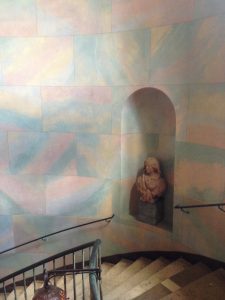

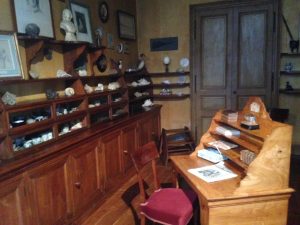
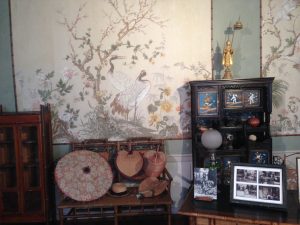
Nächste Welle
Die Surfenden unter uns wissen, „nach der Welle ist vor der (nächsten) Welle“. Altes Surferlatein, etwas abgenutzt, zugegeben. Aber in Zeiten mit Coronavirus #Covid_19 und der δ-Variante ist das #nichtLustig. Wer bekommt wann die 3. Impfung, das ist die Frage, überlegte schon Hamlet. Aus Hamlet ist längst die „Hamlet Machine“ geworden. Eine Armada von Modellierenden versucht Prognosen von Wellen und deren Auswirkungen vorherzusagen, denn riesige Finanzströme folgen solchen Projektionen. Haben sie noch keine Biotechnologieaktien in ihrem Depot, die mRNA Impfstoffe produzieren? So als Absicherung gegen höhere Krankenversicherungsbeiträge oder pandemiebedingte Risiken. Lassen wir uns also einfach das dritte Mal jetzt impfen und wir kommen höchstwahrscheinlich relativ unbeschadet durch den Winter. Die Feier zum 8-ten März werden wir wohl wieder ausfallen lassen oder verschieben, aber das ist Teil des „new normal“.

Künstlerin
Wie werde ich zur kunstschaffenden Person? Ein Lehrstück über die Soziologie und Entstehung der Profession der Künstlerin ist in Paris, im Gebäude des Senats zu besichtigen. Das Musée du Luxembourg zeigt den schwierigen Weg hin zur bildenden Künstlerin seit seiner Anfangszeit im Frankreich des späten 18-ten und frühen 19-ten Jahrhundert. Es war und ist ein schwerer Weg, in einer von Männern dominierten Welt als Frau eine Eigenständigkeit zu erreichen. Die ersten Stationen dieses Kampfes werden in der Ausstellung deutlich. Zulassung zu den Ateliers, der Ausbildung und zu „Kunst als Beruf“ mit professioneller Anerkennung und Möglichkeit, seinen Lebensunterhalt damit zu verdienen, war und ist ein kämpferisches Unterfangen. Dieser Passionsweg wird deutlich in der kleinen sehr gelungenen, soziologischen Ausstellung. Die Genealogie und Soziologie der Professionen spricht seit langem von der „gläsernen Decke“, die viele Frauen an dem Aufstieg in höhere und höchste Positionen innerhalb einer Profession hindert. Das bleibt für jede Generation von Frauen ein Kampf bei dem Ihnen nichts geschenkt wird, auch oder gerade weil, die Bilder schön anzusehen sind. So erlaubt die Ausstellung, die Frau und den Beruf hinter den Bildern zu sehen. Eine Reflektion und Projektion über die Kunstschaffenden. Ein Spaziergang im Jardin du Luxembourg ist anschließend der Erholung dienlich.
Ungleichheit
Ungleichheit über den Lebensverlauf ist ein datenintensives Forschungsprogramm. Ungleichheit beim Zugang zu Gesundheitsversorgung bei Geburt bis zur Ungleichheit beim Zugang zur Sterbehilfe, alles empirisch belegbare Evidenzen. Piketty macht vor, wie ein umfassendes Projekt zu Ungleichheit dazu aus Archiven und Steuerunterlagen Ergebnisse liefert. Ein dickes Brett, auch das tolle Buch dazu (s.u.). Der Cartoonist von „Le Soir“ (13.7.21) Kroll hat mal seine Vision von Ungleichheit in einer Karikatur zusammengefasst. Ablenken von den eigentlichen Themen #Klimakrise mit spektakulären Aktionen gibt Medienberichterstattung im Überfluss. Aber mal ehrlich, der CO2-Abdruck einzelner Millardäre kann uns nicht mehr kalt lassen. Ungleichheit beim Umweltverbrauch verlangt Schlagzeilen von Einsparrekorden und nicht über abgehobene Umweltverschmutzer. Maskuline Form hier bewusst gewählt entsprechend dem Karikaturist.

Weniger “isst” Mehr
Ein mit hohen akademischen Weihen versehener Artikel hat mal wieder bestätigt, was wir eigentlich seit den 70er Jahren bereits wissen und in den Gesundheitskampagnen “Friss die Hälfte” effektvoll angeregt wurde. Leider zeigen unsere “Obesity”-Statistiken völlig entgegengesetzte Trends. Wir werden immer dicker als Einzelne und als Gesellschaft. Dabei wissen wir es seit langem. Auch die Lösung mit der “Trimm Dich” Aktion und Waldpfaden mit Sportgeräten aus Holz hatten wir schon und haben sie verkommen lassen. Weniger essen hilft für ein längeres Leben und dadurch werden wir langfristig gesehen doch mehr essen (ein anderes Nachhaltigkeitsthema). Aber zunächst zu “Sestrin” dem Signalprotein. Zu hohe Proteinzufuhr schadet den tierischen und wohl auch dem menschlichen Organismus. Reduktion verlängert um 10% die Lebenserwartung. Das sind etwa 8 Jahre bei einer durchschnittlichen Lebenserwartung bei Geburt von 80 Jahren. Den Autoren
Jiongming Lu, Ulrike Temp, Andrea Müller-Hartmann, Jacqueline Eßer, Sebastian Grönke, Linda Partridge ist mit ihrer Studie ein wichtiger Durchbruch gelungen: Sestrin is a key regulator of stem cell function and lifespan in response to dietary amino acids. Nature Aging, 2020.
Mein Vorschlag ist: bei der nächsten Frühjahrsdiät doch mal erneut versuchen es umzusetzten. In Zeiten von Covid-19 und seinen Varianten sind die Erträge mehrfach. Da es schon wieder wärmer wird, ist der Wohlfühlfaktor warmen Essens nicht so einschränkend. Deswegen, Klaus raus aus dem Haus. 